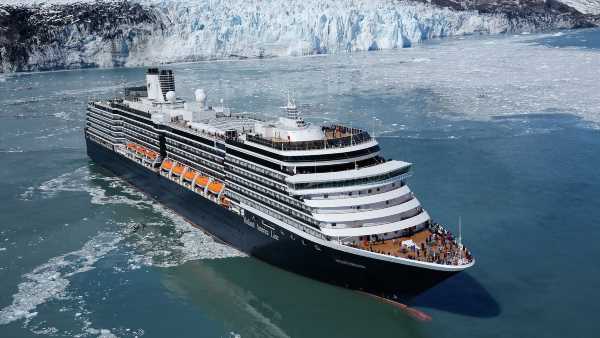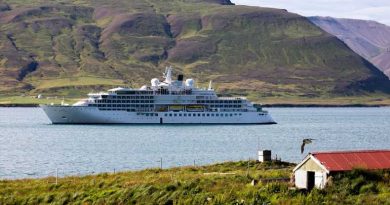Cruise lines tap Alaska demand with record deployment
With the first Alaska sailings of the season to launch in April, cruise operators are hoping their decision to put a record number of ships in the region pays off.
CLIA Alaska anticipates about 1.65 million cruisers on 50 ships will visit the Great Land in 2023, on 700 scheduled sailings. That tops 2019’s 1.3 million visitors on 37 ships.
Cruise lines, travel advisors and analysts report that Alaska bookings are strong so far this year, but some have also noted some pricing pressure.
Holland America Line, a longtime Alaska cruise leader, said Alaska bookings helped make the third week of January its best ever for that Wave season month: Alaska bookings were 25% higher than the strongest week in January 2019.
Norwegian Cruise Line (NCL) is betting big on Alaska this year by expanding its season and offering longer cruises.
The brand’s five ships will sail itineraries of nine to 11 days, in addition to seven-day trips.
“The feedback from our guests in recent years has been that they simply want more opportunities to see Alaska, and so we listened to them,” said Chad Berkshire, NCL’s senior vice president of revenue management, who added that while seven-day cruises continue to be popular, “we wanted to offer a product that allows for not only more time in port to experience the local culture but also visit ports that guests may not otherwise get to see,” such as Keystone Canyon, a small town near Valdez.
NCL will offer cruises both earlier and later in the season, which traditionally goes from May through September. The Norwegian Bliss departs Seattle for Alaska on April 15, while the line’s last sailing, on the Norwegian Encore, begins Oct. 22.
Adam Wolf of Adventure Horizons, an independent Avoya Travel Network agency, is a fan of the idea.
“Lower rates along with quieter ports are the benefits, whereas it’s nice to be the only ship in town, even if it’s cold,” he said. “Plus, the fall sailings offer the opportunity to take advantage of the jewelry store/gift shop clearance and maybe the chance to see the northern lights.”
Lindblad Expeditions similarly said that its additional capacity has allowed it to offer new Alaska itineraries.
Lindblad chief commercial officer Noah Brodsky said that Alaska demand was so high after the cruise restart that the line increased its deployment with the addition of a fourth ship.
“We’ve been pacing ahead of 2019 even with a steady increase in inventory,” he said. “We have noticed some changes in booking patterns since prepandemic, notably that travelers are booking closer to the date of departure, and we are seeing online traffic and travel advisor-sourced bookings increase notably.”
Brodsky attributes some of that increase to what he called a “renewed focus and investment on improving our brand awareness among travel advisors,” with a strengthened sales organization and newly launched trade program.
Alaskan Dream Cruises chief marketing officer, Zak Kirkpatrick said in February that booking patterns were returning to normal but still behind 2019 levels. “We can tell there’s a little bit of that pandemic lag happening,” he said. “It’s not quite to prepandemic times but seems to e coming back.”
With many ships to fill, will prices come down?
None of the brands mentioned pricing, but Truist Securities reported that during January, the 2023 cumulative booking pace for Alaska cruises overall was up 25% to 30% over 2019, but that pricing was down 7.5% to 12.5%.
Some travel advisors have also said they expect the additional capacity to dampen pricing.
“My bookings for Alaska are definitely way up for this year, as the demand with my clientele is there,” Wolf said. “But I do think there are too many ships sailing around Alaska, so the supply of available staterooms is plentiful. Not sure if the cruise lines will be able to fill every room on each sailing, unless they reduce rates for available cabins closer to the sailing date.”
Tom Garrett, owner of Union Hill Travel in Kansas City, Mo., said that Alaska bookings this year are in line with what they were in 2019 and “maybe slightly faster.”
Neither compares to Alaska bookings last year, when he said clients with canceled pandemic bookings were rebooking and travelers in general were hit with “irrational exuberance.”
This year is also the first since the pandemic without restrictions or political maneuvering around Canada, where all foreign-flagged cruise ships on Alaska itineraries are required to stop in order to satisfy U.S. cabotage laws.
Last year, a Canadian rule requiring 100% onboard vaccinations threatened to throw a wrench into the season (the rule was later relaxed); the year before that, Canada banned cruise calls outright, prompting a temporary suspension of the cabotage law to get the industry restarted.
The ability for vacationers to travel to Europe and elsewhere without restriction this year could also impact the popularity of domestic itineraries. Garrett doesn’t attribute the ability to go abroad as directly affecting Alaska bookings, but he did say that with restrictions lifted this summer, many of his clients are crossing the pond. “I’m getting a lot more people who are proactively asking about Europe,” he said.
But Alaska cruises may benefit from those choosing ships over land this year because of continued labor shortages.
Garrett said that some client feedback last summer focused on hotel quality and service levels not being commensurate with pricing. If a hotel in Anchorage costs $400 a night, he added, “and the room’s a little rough and the service is a little poor and the last $400 hotel they stayed at was in Paris,” it is not a good comparison.
Cruisers could also contend with staffing issues affecting off-ship experiences, something the industry is trying to help resolve. Renee Limoge Reeve, vice president of government and community relations for CLIA Alaska, said, “We continue to hear that while numbers are significantly better than last year,” labor concerns still exist, and CLIA is supporting efforts to solve them.
Source: Read Full Article




